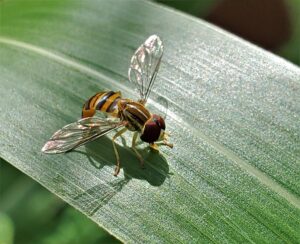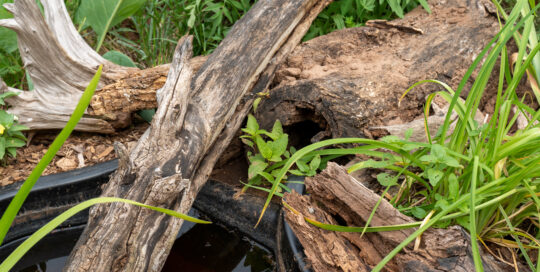Singing the praises of hover flies
Views: 310

When we think of pollinators in our gardens, bees and butterflies often steal the spotlight. However, there’s another group of unsung heroes that play a vital role in our ecosystems: hover flies, also known as flower flies or syrphid flies. These inconspicuous insects might resemble house flies, bees, or wasps, but they hold a unique place in our gardens, contributing to both the beauty and functionality of our outdoor spaces.
The Beneficial Side of Hover Flies
Hover flies are essential pollinators, supporting the reproduction of numerous plant species in North American gardens. As they visit blossoms to feed on nectar and pollen, they inadvertently transfer pollen from one flower to another, facilitating the reproductive process. This results in improved fruit and seed production for plants, which is not only important for the plants themselves but also for the wildlife that depends on them.
Unlike their stinging lookalikes, they are harmless to humans and can be easily distinguished by their large eyes and hovering flight pattern. Their ability to remain suspended in the air, much like a helicopter, is where their common name originates from.
Hover fly larvae voraciously eat soft-bodied pests like aphids, thrips, and young caterpillars. (While we may be protective of our butterfly caterpillars, we must remember that there is a natural cycle of life and death in our gardens.) By controlling pest populations, they help maintain the health of plants without the need for harmful chemical pesticides. This natural form of pest control can lead to healthier and more vibrant gardens, benefiting both the environment and garden enthusiasts. For those practicing sustainable gardening, they are particularly valuable due to their predatory larval stage.
Common Hover Fly Species in North American Gardens
These are some common species of hover flies you might find in your garden:
- Eristalis tenax (Drone Fly): Often mistaken for honeybees due to their similar coloring, drone flies are common species found in North American gardens. Their larval stage is aquatic and is often seen in stagnant water, making them excellent at breaking down organic matter in ponds and other water bodies.
- Syrphus spp.: This genus of hover flies is easily recognizable by their yellow and black striped abdomen, resembling small bees. They have widespread distribution and generalist feeding habits, making them frequent visitors to a variety of flowers.
- Toxomerus spp. (Meadow Flies): These small hover flies are green or metallic in color and can often be spotted visiting small flowers. Their larvae voraciously predate aphids, helping to control pest populations in gardens.
- Allograpta spp.: These hover flies are identifiable by their distinct bands of yellow, black, and white on their abdomen. They pollinate various wildflowers and crops, contributing to the overall biodiversity.
Encouraging Hover Flies in Your Garden
To attract hover flies to your garden, incorporate a variety of nectar-rich flowers. Hover flies are known to seek out plants like asters, daisies, marigolds, and sweet alyssum. Creating a diverse and colorful garden not only appeals to our aesthetic senses but also provides these beneficial insects with a reliable food source.
While bees and butterflies certainly deserve their recognition as pollinators, hover flies are equally deserving of our attention and admiration. These unassuming insects bring a unique blend of pollination and pest control to gardens, supporting both the environment and the beauty of our outdoor spaces. So, the next time you spot a hover fly hovering around your flowers, take a moment to appreciate the important role it plays in the intricate tapestry of your garden’s ecosystem.
Meet Leslie Miller
Leslie Ann Miller shares 3.5 acres in rural Oklahoma with birds, butterflies and wide variety of animals. She is currently transforming her yard with plantings…
Leslie's Recent Posts

Creating microclimates and microhabitats to benefit wildlife






